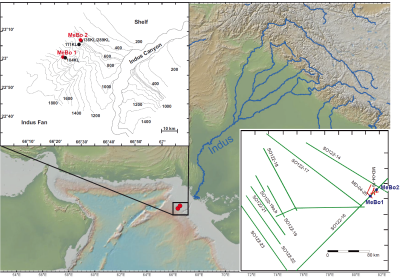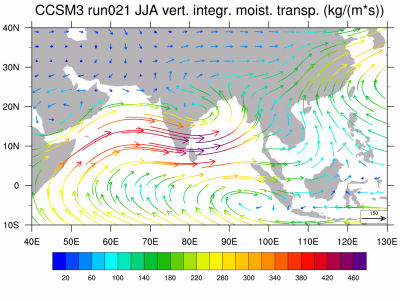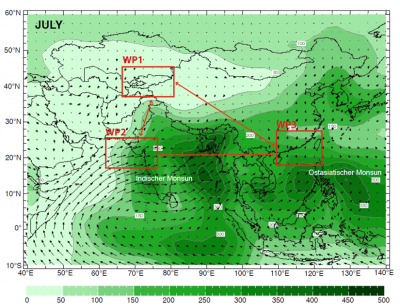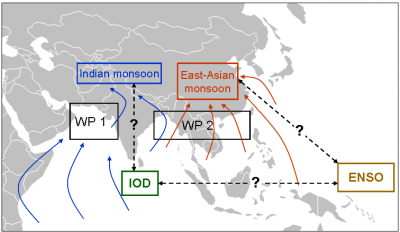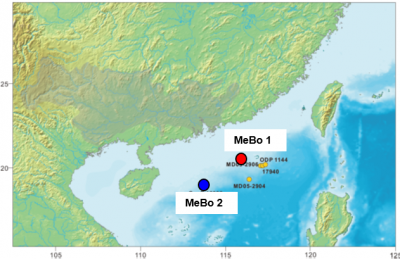Monsoon
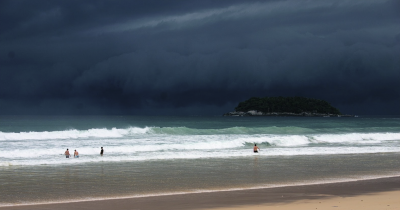
The monsoon system represents one of the essential elements of the global atmospheric circulation and determines the environmental and living conditions in large parts of the densely populated regions of the world. About two-thirds of the world population depends on the rainy summer monsoon for water supply and agriculture and therefore, knowledge about the development and dynamics of the monsoon in the recent geological past is of great importance.
A large part of our research activities deals with the topic "monsoon". By combining reconstructions and model simulations, we try to better understand the control factors and feedback mechanisms of the monsoon systems on different timescales. On this topic, we work together with colleagues from the PR China, Japan, India, Sri Lanka and the USA.
SAMOVAR (BMBF)
South Asian summer monsoon variations during interglacials (2 years)
Rapidly accumulating sediments from the Indus slope in the northeastern Arabian Sea are ideal for reconstructing the history of the South Asian summer monsoon (SASM) rainfall. By using the MARUM drill-rig MeBo200 to sample two sites off the Indus River mouth, it is planned to reconstruct temperature and rainfall changes during Marine Isotope Stages (MIS) 5, 11 and 21. Reliable SASM rainfall reconstructions from these interglacials do not exist so far, although MIS 11 around 400,000 years ago represents the best analog for present climate with similar sea level, greenhouse gas concentrations, and insolation forcing. This comparative analysis of interglacial SASM rainfall variability improves our understanding of the response and sensitivity of the SASM to different forcing mechanisms under different interglacial boundary conditions, as well as its connection to the other monsoon systems.
Monsoon dynamics (DFG)
MARUM-Excellence cluster “The ocean floor”, RECORDER 1 "Perturbations" (2022-2025)
Sea surface temperature (SST) simulation is one of the main sources of error for projecting future rainfall. Deciphering the coupling between SST and monsoonal rainfall is thus crucial to better understand monsoon dynamics and project the future development of monsoon systems. However, the connection between SST and monsoon rainfall in the past has yet to be studied in a systematic approach.
In this project, we will compile available and newly generated SST and rainfall records from the Australasian monsoon realms to analyze existing trends and variability across the Holocene and previous interglacial periods as “warmer-than-present world” analogues. The proxy data basis will be combined with numerical model simulations that address the SST influence on monsoon rainfall.
CAHOL (BMBF)
Cental Asian Holocene Climate (2016-2019)
Modern observations and model simulations show that the position of the westerly winds is controlled by climate changes in the North Atlantic, confining the Asian monsoon range to the north. This correlation between the regional monsoon strength and the position of the westerly winds in Asia is of crucial importance for the precipitation regime in large parts of Asia. However, the brevity of the instrumental data series does not allow reliable conclusions on the periods and interactions of these climate phenomena.
This project tests the hypothesis that prolonged phases of the Atlantic Multidecadal Oscillation (AMO) or the North Atlantic Oscillation (NAO) can cause tipping points in the Asian monsoon climate due to a longterm shift in the westerly wind systems. For this purpose, new sediment archives in the westerly wind system (Kyrgyzstan), the Indian monsoon (northern Arabian Sea) and the East Asian monsoon (South China Sea) will be examined in order to improve our understanding about phase shifts and teleconnections between North Atlantic, westerly winds, and monsoon systems.
CARIMA (BMBF)
Natural versus anthropogenic controls of past monsoon variability in Central Asiarecorded in marine archives (2012-2014)
This project aims at a better understanding of monsoon dynamics at timescales of societal relevance. We employ high-resolution marine climate archives and novel proxies in combination with climate modeling in order to disentangle natural from human-induced variations in the South and East Asian monsoon systems, by using proxies that reflect environmental conditions on land, specifically, changes in vegetation, hydrological and carbon cycles.
INVERS (BMBF)
Interglacial variability of the East Asian Summer Monsoon (2012-2013)
Changes in the East Asian summer monsoon are driven by natural factors, however, in recent times to an increasing degree also by anthropogenic factors. The relative weighting of these controlling factors needs to be known, in order to prognosticate the variability of precipitation in Central Asia, which is of enormous importance for the development of regional national economies.
In this project we collect highly resolved marine climate archives using the Bremen Sea Floor Drill Rig (MeBo) in the northern South China Sea. Novel proxies applied to these archives allow to reconstruct the natural variability of the East Asian summer monsoon during the last interglacials, with a focus on changes in the vegetation and the hydrological cycle in the watershed of the Pearl River during this climate period.



